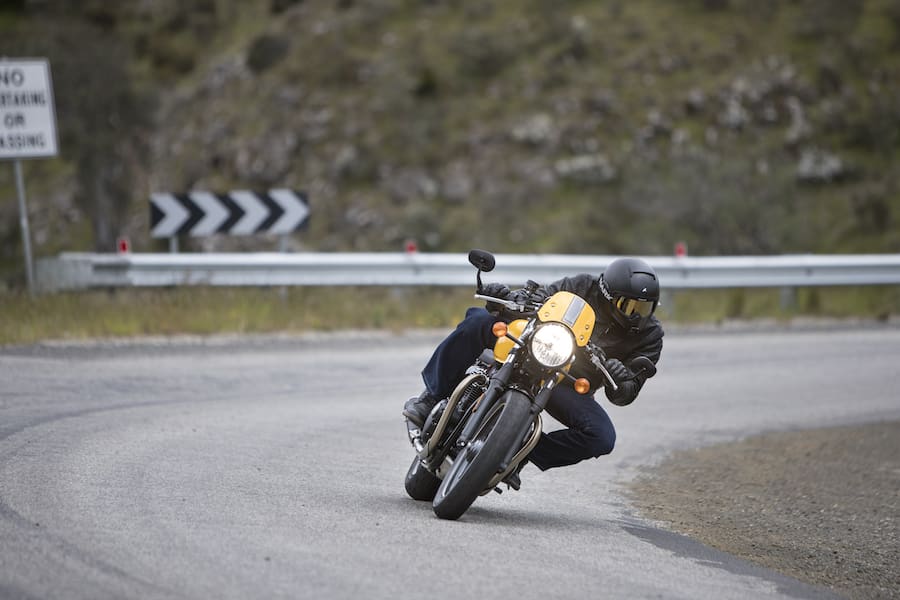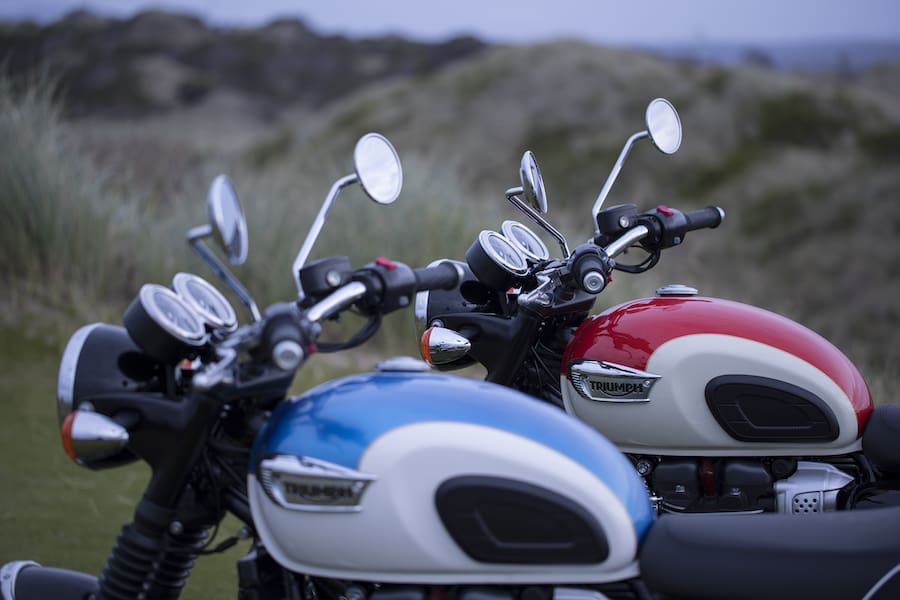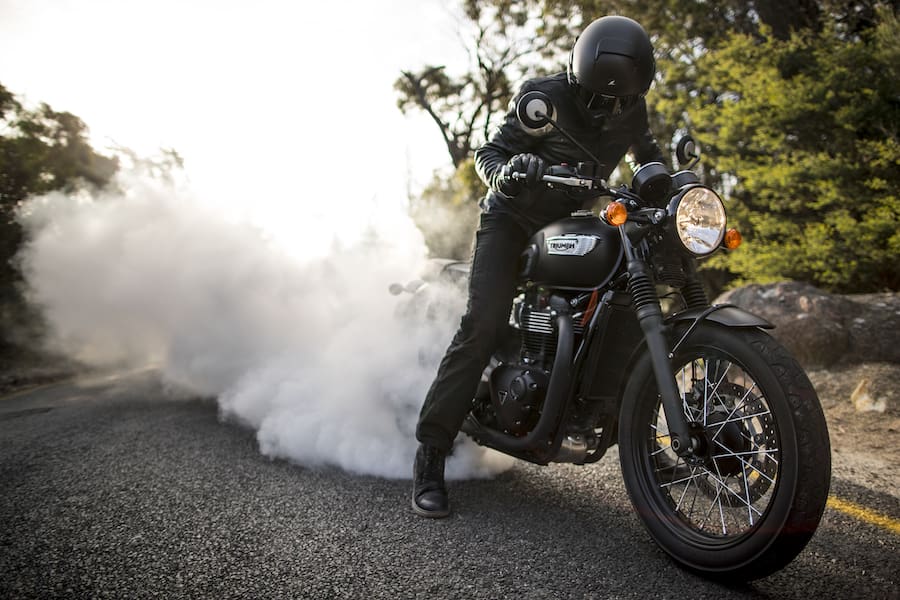Triumph is forging a reputation as an industry leader when it comes to creating ‘modern classics’. Over the past 12 months it has released a new range of liquid-cooled models to meet Euro 4 emissions rules and reinvigorate its retro stable.
It’s a marque steeped in tradition, but in recent years Triumph has evolved from the firm that almost allowed Steve McQueen to evade the Nazis in The Great Escape to a 21st-century global success story. Since taking the helm in 1983, construction magnate turned motorcycle manufacturer John Bloor has completely reinvented the brand. The revival of this iconic British marque and its flagship Bonneville has been met with mixed opinions, but one thing is clear – it is changing with the times.
Diehard T100 fans probably made up their minds about the company well before Bloor’s first ‘modern classic’ was unveiled back in 2001, so the real question here is whether the ‘all new’ T100 line-up will make enough of a statement to attract the next generation of Triumph aficionados.
We flew down to Tasmania for a four-day test of two new Triumph models based on the same 900cc parallel-twin platform: the T100 and the Street Cup.

They say:
The Street Cup is the urban sports Bonneville, and a stunning new addition to the ‘Street’ Family. Born from the stripped back style of the Street Twin, it delivers a stunning street racer attitude, bringing together the minimal bodywork details and contemporary finishes of the Street Twin, with a host of new urban sports features, such as an authentic bullet seat and removable café racer seat cowl.
PMAC says:
This bike is ideal for riders who want the cool, retro styling without compromising on performance. The Street Cup aims to tap into the booming production ‘café racer’ market, and the T100-powered street scratcher appears to deliver the best of both worlds. The skin deep retro styling does a reasonable job of disguising the bike’s modern engineering, and the pseudo-classic look should appeal to young and old alike. Little touches like re-routing the header pipe behind a shroud to run via a catalytic converter, a tailored bullet seat, and ’bar-end mirrors that actually work, suggest that this build is both clever and well thought out.
The finish includes hand-painted pinstriping on the tank, a two-tone paint job that comes in emo black or peacock yellow, and twin-analogue dials with a built-in digital display that sits neatly behind the colour-coordinated fly-screen.
From a glance, the Street Cup appears minimalistic and clean, but those in the know will see a blank canvas with endless possibilities. It’ll still turn heads in stock trim, but Triumph knows their target market all too well and has created more than 120 accessories for customisation.
They say:
With dynamic urban sports focused ergonomics, dropped ‘Ace’ bars and dedicated rear suspension, the new Street Cup delivers an engaging riding position with smooth and agile handling.
PMAC says:
The capable KYB suspension package, stiff tubular steel chassis, and light feel of the Street Cup’s handling are confidence inspiring. And what better place to test such a ‘club racer’ styled machine than isolated back roads which play host to our nation’s greatest tarmac rally – the Targa Tasmania.
The coarse bitumen was ideal for putting the soft-shouldered Pirelli Phantom Sportscomp tyres through their paces, and with so much ground clearance provided by the Street Cup’s Thruxton R ‘style’ rearsets, it was almost a rite of passage to push this bike all the way to the edge just like the original TT-racers did in days long past. But you don’t have be in full race tuck to appreciate the Street Cup’s ergonomics.
This motorcycle’s engaged riding position and race-oriented ‘bars don’t come at the expense of comfort and practicality.
I’m six feet tall and spent several full days riding this model without any aches or pain. A big plus in my book for any road-burner.
They say:
The 900cc high-torque Bonneville engine is perfectly tuned for a blast around town, or escaping it all on twisty B-roads. Wherever you ride you are always accompanied by a raw, rich soundtrack from its shorter, lighter twin upswept satin black and stainless steel silencers.
PMAC says:
The claimed output (80Nm @ 3200rpm; 40.5kW @5900rpm) from this neat and narrow engine make it well suited to nipping through traffic, but the predictable, oversquare motor also lends itself to longer trips and spirited back country scratching when the opportunity arises.
The Street Cup weighs in at 200kg dry and accelerates cleanly from as low as 2000rpm all the way until 6000rpm when it’s time to hook the next gear. The five-speed gearbox is crisp and clean with a reassuring firmness that suggests it will withstand heavy use and hold up well in the long term.
The bellow from the 2-2 megaphone exhaust system erupts from deep within the 900cc parallel-twin engine. The rumbling beat that crescendos as you pick up the revs begs to be turned up loud with a twist of the throttle, but it’s never quite enough. I’d like to hear the Street Cup’s addictive growl unleashed with a pair of the Vance and Hines slip-ons from Triumph’s accessories catalogue, but I’m also the kind of rider that would fit the Fox rear shock units (RSU) and take this bike to the track. Actually, scratch that – I would take it to the track regardless.

They say:
The sensitive incorporation of rider focused technology, ride-by-wire, switchable traction control, ABS, torque-assist clutch and low seat height, provide an enhanced level of confidence, comfort and control.
PMAC says:
Ride-by-wire has changed the way we appraise modern motorcycles. And now, thanks to Triumph, even ‘modern classics’. Unlike the T120 there are no engine maps to choose from, but switchable traction control (on or off) is present. The TC setting reverts to default (i.e. on) when the kill switch is triggered so keeping it off can be a challenge, but from a regulatory point of view you can see the logic. In all honesty, you would have to try pretty hard to get the rear wheel to break traction on anything but an unsealed road – even in the wet – so I can only assume that this addition is more for psychological reassurance or compliance purposes. On the flipside, the torque assist clutch is a great asset. This simple but effective mechanism worked superbly and although I tried to upset the bike with ham-fisted downshifts, it just soaked up the revs and remained stable with little more than a slight juddering from the rear.
The low 780mm seat height on the Street Cup means even the most vertically challenged rider should be able to flat foot it.
They say:
Service intervals extended from 10,000km to 16,000km
PMAC says:
Not only has Triumph blown the competition into the era from which they were based with this new range of modern classics, they’ve also hit the nail on the head by slashing maintenance costs. I wouldn’t be waiting the prescribed 16,000km to the first minor service before changing engine oil, but according to the propeller heads at Castrol, it’s absolutely fine. Valve clearances are easier too now thanks to some easily accessible jugs connected to a single injector and throttle body via a t-pipe.
DIY’ers will be pleasantly surprised by the T100 engine, but for the cut-price cost of getting genuine services most owners will likely return to their dealer – a win for both the industry and the consumer.
2017 Triumph T100 Bonneville
They say:
An original for everyone. Beautifully styled and now even more accessible, the Bonneville T100 and T100 Black are great new entry points to the classic Bonneville family.
Inspired by the iconic ‘59 Bonneville, the T100 models have their own distinctive character that incorporates more of the original Bonneville DNA, along with many of the stunning finishes, features and details of the larger Bonneville T120 and T120 Black.
PMAC says:
The Bonneville will always stand out from the crowd with its premium badging and rubber knee pads. It’s as quintessentially British as Marmite, and with more than 150 accessories available from Triumph your only challenge will be selecting which parts to customise.
The model’s heritage is a pivotal aspect of this build, but this 900cc replica of the T120 is still out of reach for L-platers in Australia. Creating a 650cc LAMS legal Bonnie seems the obvious choice to coax a generation of newcomers onto Triumph’s modern classic bandwagon, but whether or not the model will appear in this capacity in the future remains to be seen. The ‘Black’ variants (available in matt black and jet black paint schemes) will also appeal strongly to the new generation of retro-philes who would otherwise be considering custom builds with donor bikes of questionable vintage and quality.
The T100 saves 11kg over the T120, cutting weight by leaving out switchable engine modes, twin throttle bodies and injectors, heated grips, a grab rail, centrestand, and twin brakes. Although it doesn’t sound like much when you take into account the 25Nm/18kW deficit compared to the larger model, this reduction in unsprung mass actually amounts to a much greater ease of handling and manoeuvrability at slow speed.
Sometimes the old saying ‘good things come in small packages’ rings true, and it helps that the T100 is almost $2000 less than its big brother. Still, I’m not sure that will be enough to sway everyone.

They say:
The T100s offer thrilling performance from the 900cc high-torque Bonneville engine, delivering greater torque, better fuel economy and a rich deep exhaust note.
PMAC says:
The engine performance is smooth and predictable, but thrilling may be overstating it a little. Triumph has managed to eke out 18 per cent more torque (claimed) on the outgoing 865cc engine by incorporating a 270º firing interval and liquid cooling in addition to more cubes. However, this does come at the cost of greater engine weight and less peak power. Nonetheless, Hinckley’s head honchos have managed to meet Euro 4 emissions standards which is a tall order for any marque these days, and in doing so established a platform that will conform to more stringent requirements in years to come.
Fuel consumption is 36 per cent more efficient (3.7L/100km claimed) than the previous generation engine, but regulation 168/2013/EC test conditions differ significantly to those we experienced on road (5.1L/100km measured) so I wouldn’t go counting your pennies too early. The Street Cup’s dainty 12L fuel capacity may amount to more fills on average than one would like, but, like all great motorcycles, Triumph’s modern classics are endowed with a range indicator so it shouldn’t come as a nasty surprise. The T100 Bonnie has a 14.5L tank which gave an average consumption of 4.6L/100km over two days of riding.
Twin pea shooter exhausts are a centrepiece of the Bonnie legacy, and with twin skins they should hold their chrome finish (or matt black in the case of the T100 Black) well into the future. The exhaust note is quiet but charismatic, and leaves a lingering note that hangs in the air like thick, sweet tyre smoke.
They say:
The dedicated T100 chassis and suspension work together to provide a smooth ride, along with easy, neutral handling and sensitive incorporation of rider focused technology, with ABS, traction control and a torque-assist clutch to give that extra level of comfort and control.
PMAC says:
The all new T100 Bonneville has a stiffer chassis and shortened wheelbase which help the bike to hold a line while cornering. Tipping into corners is also vastly improved over the outgoing model with the upgraded 41mm KYB cartridge style unit and steeper rake/reduced trail. This year Triumph opted for an 18-inch wire wheel on the front, and that too plays a part in helping the whole package turn in, and maintaining stability mid-corner.
The bench seat is not only comfortable for the rider, but also well suited to two-up duties. If you plan on carrying a pillion frequently, the preload on the rear shock is easily adjusted.
The non-switchable ABS, and switchable TC (on/off) systems come into their own when the road conditions turn to slime, or pavement transitions to unsealed roads. Upright ’bars give plenty of control and leverage, and it’s possible to relax even when riding on gravel. Overall, the T100 Bonneville really is a bike that will deal with almost anything you can throw at it, while remaining surefooted and compliant.

By Paul McCann











